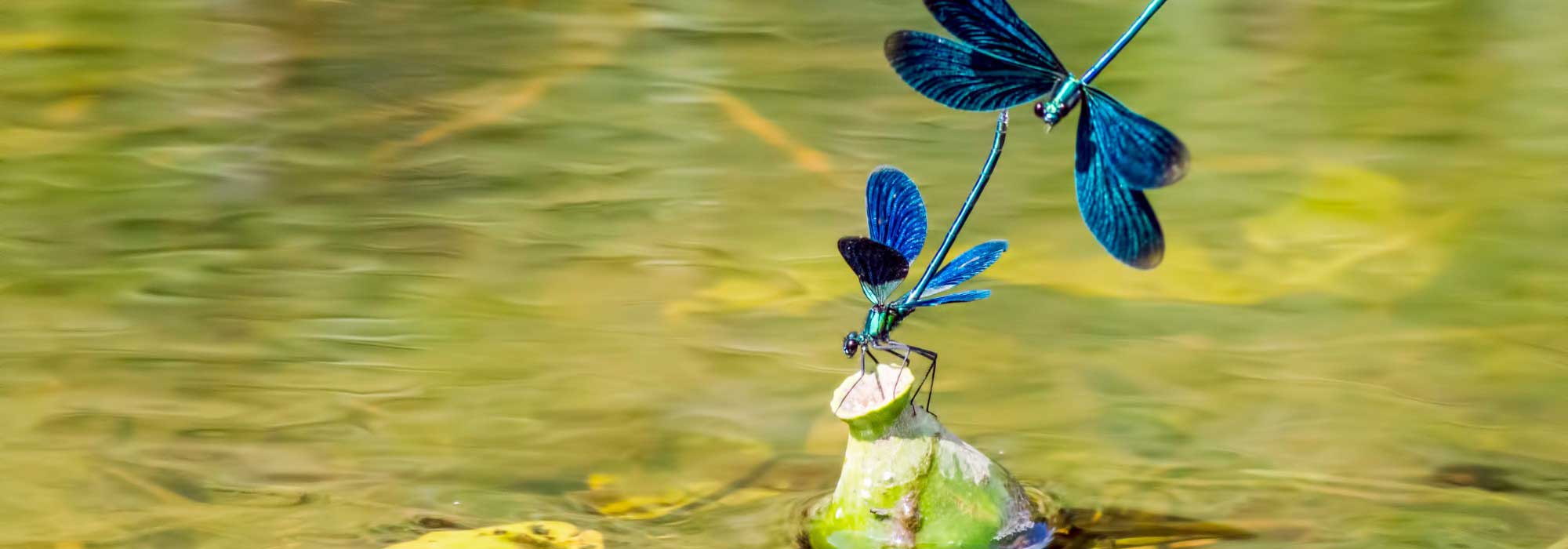
Dragonflies, frogs, birds… install a pond to welcome them!
How to create a welcoming pond for wildlife
Contents
Installing a pond in your garden, even a small one, is an incredibly beneficial step for local biodiversity. By providing a water source and shelter for many species, you create a miniature ecosystem where wildlife can thrive. In addition to its ornamental aspect, a natural pond contributes to the ecological balance of the garden, transforming it into a true haven for life. Discover all our tips for creating a welcoming pond for wildlife, particularly for insects, amphibians, and birds.
Why attract wildlife to the garden?
Attracting local wildlife promotes diversity and strengthens natural balances in the garden. A well-designed pond becomes a convergence point for many animals. Amphibians, such as frogs, newts, or toads, find an ideal place to breed and feed. They also play an important role in regulating insect populations, particularly mosquitoes, as they consume their larvae. The frog feeds on many harmful insects: mosquitoes, moths, cockroaches, caterpillars… Dragonflies and damselflies, for their part, do not just add a poetic touch to the place: they are formidable predators of harmful insects. They are particularly large consumers of mosquitoes (dragonfly larvae feed on mosquito larvae).
Many birds will also visit the pond, whether to drink, bathe, or hunt. Robins, tits, and goldfinches can be attracted by a stable water source rich in life. On the periphery of the pond, you will also see wild bees, butterflies, and hoverflies, which are valuable for the pollination of your plants. A pond, in short, attracts a chain of natural interactions, beneficial for the entire garden.
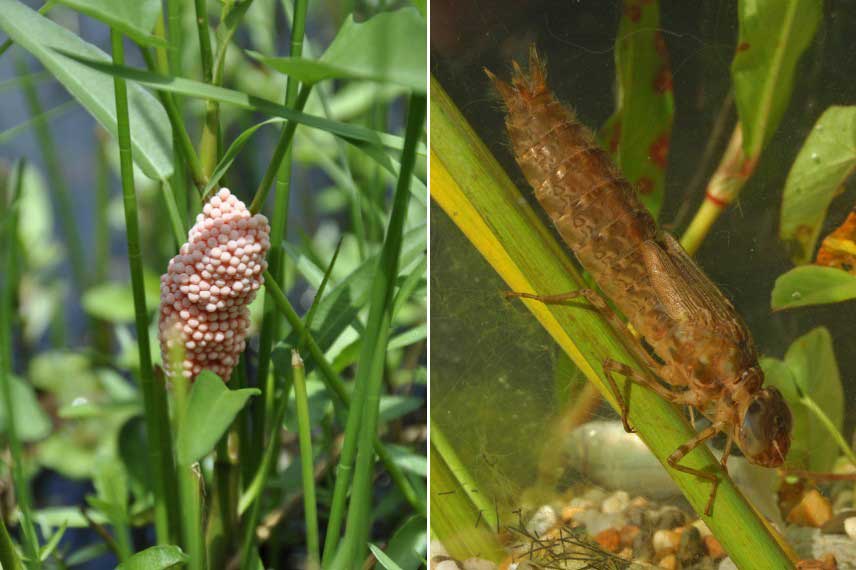
Eggs and dragonfly larva
The needs of animals for sustainable settlement
For this wildlife to settle and remain in your garden, it is essential to follow a few basic rules. Water must be clean and stagnant, without overly powerful mechanical filtration or constant turbulence, as this would disturb aquatic insects and amphibians. The pond must have gentle slopes on the edges to allow animals to easily enter or exit, particularly young frogs or small mammals like hedgehogs that may come to drink.
It is also essential to create shallow areas (10 to 20 cm) that warm up quickly in the sun and serve as natural nurseries. Conversely, a deeper area (up to 1 m) allows animals to take refuge during extreme heat or winter frost. Additionally, this depth will prevent the pond from drying out in summer. Frogs hibernate underwater at a depth of at least 50 cm to protect themselves from freezing. The pond must remain filled throughout the year to ensure the survival of frogs.
It is strongly advised against introducing fish or ducks into the pond, as they may eat tadpoles and frog eggs, dragonflies, etc., compromising the establishment of many beneficial species.
It is important to create a gentle slope on at least one side of the pond to facilitate access for animals. Avoid steep slopes.
Preserve wild spaces around the pond: meadow, tall herbs, wild plants, hedgerows… And install stones and pieces of wood around the pond to provide shelter for animals.
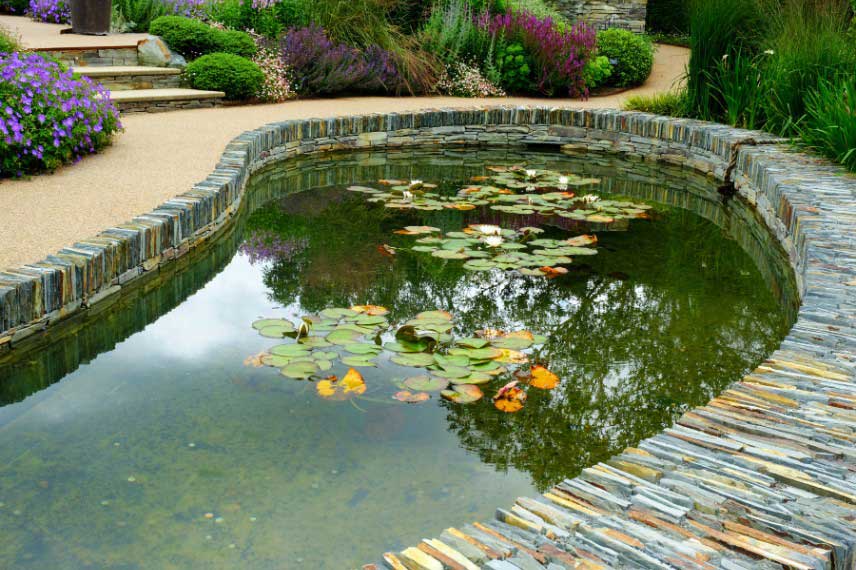
An example of a pond that is not suitable for wildlife: steep edges, low plant diversity, and no plants, wood, or stones immediately bordering the pond
How to create a natural and welcoming pond for wildlife?
Here are the main steps to follow to install a pond that attracts dragonflies, frogs, and birds:
-
Choose a semi-shaded location, ideally exposed to sunlight in the morning and shaded in the afternoon. There should be at least 6 hours of sunlight per day. Avoid overly windy areas or those directly under large trees to limit leaf fall into the water.
-
Draw the shape: an irregularly shaped pond integrates better into the garden and offers more habitat diversity.
-
Excavate the pond with varying depths to accommodate a greater diversity of plants and provide different habitats for animals. Plan for several shelves: a very shallow area (10–20 cm), a medium area (30–40 cm), and a deeper central part (at least 60 cm deep, to promote frog hibernation).
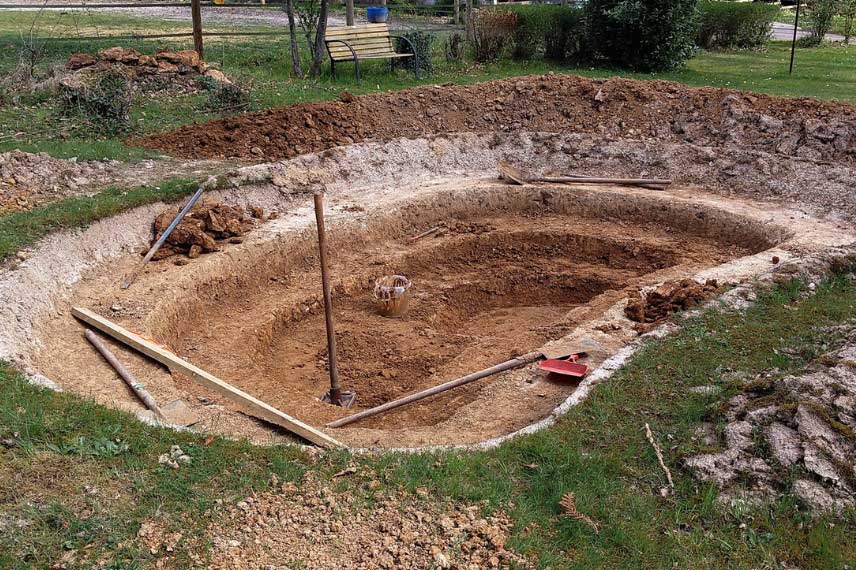
Excavate the pond with several shelves, with a shallow depth on the edges and a greater depth in the centre
- Install a layer of sand or geotextile felt to protect the liner from roots and stones.
-
Install the liner: line the bottom of the pond with a special pond liner (made of EPDM or PVC) or opt for a preformed rigid plastic container.
-
Fill the pond with rainwater (preferably), which contains neither chlorine nor chemicals. If you use tap water, let it sit for a few days in a tub before adding it, to eliminate the chlorine.
-
Landscape the edges of the pond: stabilise the banks with stones, pebbles, or suitable plants. Plan for gentle access areas (sloped or terraced) to allow animals to drink safely and easily exit the water.
-
Plant according to zones: install aquatic plants according to their depth requirements (submerged, floating, marginal), then complement with wetland plants and ground covers around the pond to enhance the ecological effect.
 Install the plants in the centre or on the edges of the pond, according to their needs
Install the plants in the centre or on the edges of the pond, according to their needs
To attract birds, feel free to install birdhouses near the pond. For dragonflies, add melliferous plants in or around the pond.
You can also take some water from another natural pond to “seed” the one you have just created: this will accelerate the establishment of microorganisms, aquatic insects, pollarded trees, etc.
Once in place, let nature do its work. The pond will gradually balance itself, welcome its first visitors, and become a fascinating place to observe throughout the year.
Which plants to install in and around the pond to promote biodiversity?
The choice of plants is essential to make your pond a true living ecosystem. Each plays a specific role: water purification, shelter, spawning support, food source… Here is a selection of plants suitable for installation according to their preferred zone.
Submerged plants (oxygenating)
These plants live below the water’s surface and ensure good water quality by producing oxygen and absorbing excess nutrients.
-
Myriophyllum (Myriophyllum spicatum) : plant with long, very flexible and feathery stems, very effective for oxygenating water. Provides numerous hiding places for dragonfly larvae and pollarded trees.
-
Callitriche (Callitriche stagnalis) : small plant with submerged stems, producing rosettes at the water’s surface.
- Hippuris (Hippuris vulgaris) : rhizomatous plant with erect stems 20 to 50 cm high. Their emergent part, resembling small fir trees, serves as a moulting post for dragonflies and shelter for amphibians.
Also check out our article: “8 aquatic plants for oxygenating ponds or marshes” and Invasive aquatic plants: how to recognise and limit their spread as some can be problematic.
Floating plants
They limit direct sunlight on the water, preventing algae proliferation, while providing shade and shelter.
-
Water lilies (Nymphaea) : very decorative, they also provide refuges under their leaves.
-
Pistia (water lettuce) : perfect for small ponds, it floats freely creating small cool areas.
Marginal plants
They settle in very shallow areas and create shelters for insects, amphibians, and birds.
-
Marsh iris (Iris pseudacorus) : attracts pollinating insects and structures the edge of the pond.
-
Water mint (Mentha aquatica) : pleasant fragrance, highly valued by bees.
-
Lythrum (Lythrum salicaria) : beautiful mauve flowering, rich in nectar.
-
Juncus (Juncus effusus) : its dense stems protect young frogs and small insects.
-
Reeds : long upright stems and truly decorative feathery spikes. They help to stabilise the banks and provide shelter for small mammals and passerines.
- Carex : forms clumps with long green leaves. Valued by frogs. Stabilises the banks.
Wetland plants
These plants thrive in moist to waterlogged soil, but not submerged. They extend the pond’s effect on local biodiversity.
-
Meadowsweet (Filipendula ulmaria) : attracts pollinating insects, especially butterflies.
-
Lysimachia (Lysimachia vulgaris) : very melliferous, ideal for wet edges.
-
Horsetail (Equisetum fluviatile) : adds a graphic touch, excellent for biodiversity.
By varying heights, shapes, and types of vegetation, you promote a rich and balanced biodiversity. Also consider favouring local species, better adapted to the climate and the needs of wild species in your area.
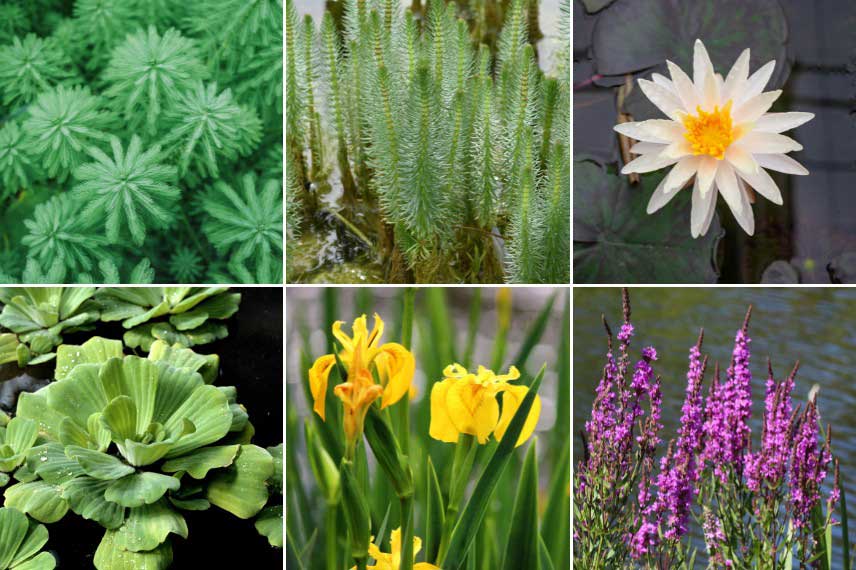
Myriophyllum spicatum, Hippuris vulgaris, Nymphaea, Pistia stratiotes, Iris pseudacorus, Lythrum salicaria
How to maintain a natural pond?
A natural pond requires little maintenance, but a few simple actions can help keep it healthy. In autumn, remember to remove the dead leaves that have fallen into the water to prevent them from rotting and releasing too much organic matter. This will limit the siltation of the pond. In spring, a light cleaning can be carried out (to remove any algae, debris, dead leaves, etc.), without removing all the silt, as it houses many useful microorganisms. In summer, monitor the water level, especially during dry periods, and top up with rainwater if necessary.
Do not use chemical products (pesticidal, etc.) near the pond and let nature self-regulate. A balanced pond will quickly find its rhythm: algae may appear at the beginning of the season, but they will soon be outcompeted by other plants if they are well established.
For more details, consult our guides: Maintaining a garden pond in spring; Maintaining a garden pond in autumn and Maintaining a garden pond in winter.
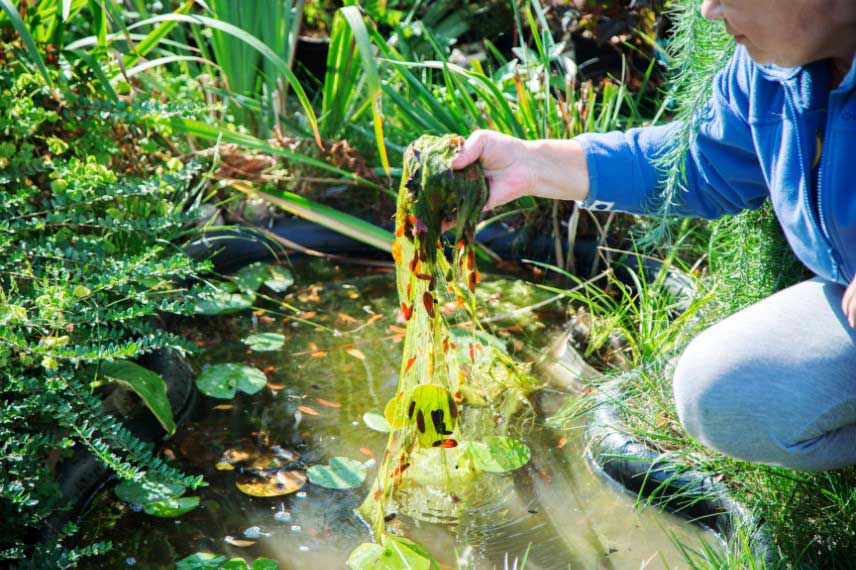
Filamentous algae can suffocate the pond and disrupt the biodiversity of the pond. Remove them if you notice they are proliferating.
- Subscribe!
- Contents
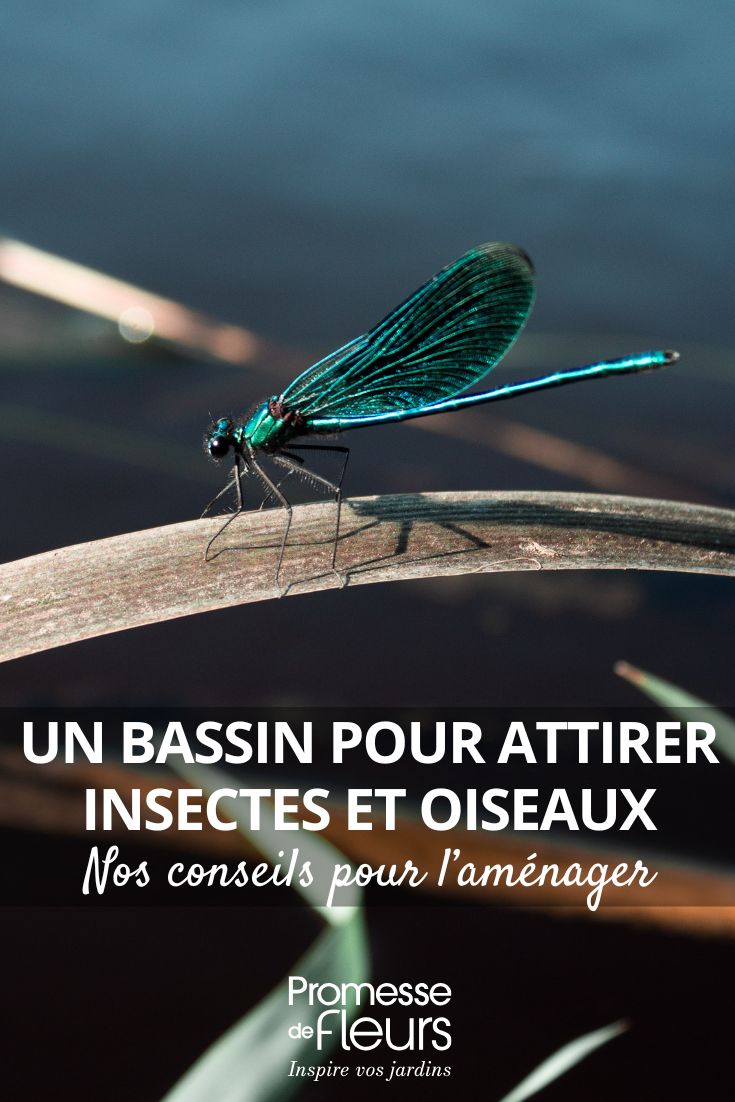































Comments